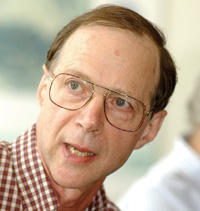Commentary: Boris Kayser
 Photo: Reidar Hahn, Fermilab |
The APS Neutrino Study: A grass-roots effort
The last seven years have greatly enhanced our understanding of neutrinos. Groundbreaking experimental results have come in at record pace, and neutrino scientists have barely had time to rebuild the conceptual matrix by which we hope to understand them. The discovery that neutrinos have mass and that they can change from one type to another has raised many questions. The answers will reach well beyond neutrinos: they will affect our understanding of the evolution of the universe, and our quest for a fundamental theory of the subatomic world.
To find the answers, scientists and policy makers need an effective, coherent strategy. To develop such a strategy, the American Physical Society initiated a year-long experiment, also known as the APS Study on the Physics of Neutrinos. Four APS Divisions -- Nuclear Physics, Particles and Fields, Astrophysics, and Physics of Beams -- sponsored the Study, reflecting the inherently interdisciplinary nature of neutrino physics.
For the first time ever, the APS asked a diverse community of scientists to examine a field of research and, if possible, to move toward agreement on the next steps toward answering the questions that drive the field. In other words, the study was a grass-roots democratic effort to lay the scientific groundwork for the choices that must be made during the next few years.
Together with Stuart Freedman of the University of California, Berkeley, I had the pleasure of chairing the 13-member Organizing Committee, an interdisciplinary team with significant international participation. The committee set up seven independent working groups, each one investigating a separate experimental approach to advancing our knowledge of neutrinos. More than 200 scientists from many different institutions and collaborations participated. The working groups attacked their assignments independently, occasionally interacting with one another to coordinate and compare approaches. At a meeting in Snowmass in June 2004, the groups presented and discussed their independent findings and recommendations.
An important -- if challenging -- goal was to agree on recommendations and priorities regarding the future of neutrino physics. To help achieve that goal, the Organizing Committee named a Writing Committee, consisting of nine physicists, chaired by Hamish Robertson of the University of Washington. Its charge was to build consensus and to integrate the Working Group findings and the opinions expressed at the Snowmass meeting into a coherent plan for the future -- no small task. After intensive work, the Writing Committee submitted its draft report to the Study's organizing committee and the working group leaders for their approval.
The report, dubbed The Neutrino Matrix, was made public in November 2004. It identifies the most important and interesting open questions in neutrino physics, examines the potential of various proposals to answer them, and recommends an effective US role within a successful global experimental program.
The Neutrino Matrix makes three principal recommendations. The highest priority has been given to a phased program of sensitive searches for neutrinoless nuclear double beta decay, and to a comprehensive US program to complete our understanding of neutrino mixing, determine the character of the neutrino mass spectrum, and search for CP violation among neutrinos. In addition, the report recommends the development of an experiment to make precise measurements of the low-energy neutrinos from the sun.
These recommendations ensure a diverse, scientifically rewarding, and cost-effective global neutrino program. The US program components will be a sound investment in fundamental physics, providing unique information and complementing companion studies that will be carried out elsewhere. Together with the existing neutrino programs and the R&D on long-term possibilities, the future program will lead to exciting discoveries, with potential for finding the truly unexpected.
There are rare moments in science when a clear road to discovery lies ahead and when broad consensus exists about the steps to take along that path. The scientists participating in the APS Neutrino Study believe that this is one such moment.
Boris Kayser is a member of the Theory Department at Fermilab. He served from 1972 to 2001 as the Program Director for Theoretical Physics of the National Science Foundation.
The full report of the APS Neutrino Study, The Neutrino Matrix, and the reports from the Working Groups may be found at http://www.aps.org/neutrino/
Click here to download the pdf version of this article.


